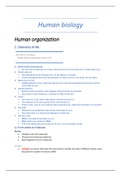Resume
Samenvatting Menselijke Biologie En Ziekteleer
- Établissement
- Katholieke Universiteit Leuven (KU Leuven)
Dit is een samenvatting van Menselijke Biologie en Ziekteleer waarin de ppt's en notities in verwerkt zijn. Ook wordt belangrijke informatie van het boek uitgelegd. 2 jaar geleden was het nog een Engelstalig vak. De inhoud is hetzelfde gebleven, maar nu zijn er ook een paar gastlezingen over specid...
[Montrer plus]



